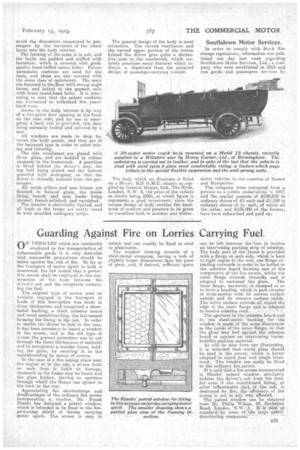Guarding Against Fire on Lorries Carrying Fuel.
Page 17

If you've noticed an error in this article please click here to report it so we can fix it.
ON VEHICLES which are constantly employed in the transportation of inflammable goods • it is very desirable that reasonable precautions should be taken against the risk of fire. So far as • the transport of motor spirit in bulk is concerned, the law insists that a protective screen shall be emf-)loyed in the construction of the body between the diver's cab and the receptacle containing the fuel.
The original type of screen used on vehicles engaged' in 'the transport of loads of this description was made in three thicknesses and comprised a sheet'metal backing, a. thick asbestos board _ and weed matehboardieg, the last-named forming the lining in the cab. • In order to enable the driver to look to the rear, it has been necessary to insert a window in the screen, arid in the old -type of• careen the general procedure was to cut through the three thicknesses of material and to incorporate a wooden frame, holdbig the glass, by securing it to the matchboarding by means of screws.
In the ease of a fire taking place near the engine or in the cab, a screen built on such lines is liable to damage, inasmuch as the fratne may be burnt and the glass broken, leaving an aperture through whichthe flames can spread to the tank' at the rear.
Appreciating the shortcomings and disadvantages of the ordinary fire screen incorporating a window, Ni-. Frank Blanks has designed a patent window, which is intended to be fixed in the fireprotecting shield of lorries carrying motor spirit. The screen is easy to
attach and can readily be fixed in steel or aluminium., The window framing consists of a sheet-metal stamping, having a web of slightly larger dimensions ti?an 'We pane of glass, and, if desired, sufficient space can be left between the two to receive; an intervening packing strip of asbeStos. The body part of the frame is provided with a flange at oath side, which is bentat right angles to the web, one flange et. tending outwards in order to be bolted to the asbestos board forming one of the components of the fire screen, whilst the other flange extends inwardly and is
adapted to surround the glass. The inner flange, moreover, is stamped so as to forM a beading, which is part. circular in cress-section with its convex surface . outside and its concave .surf ace .inside. • The latter surface extends all rothicl the edge of the inner flange and is adapted to receive asbestos cord., •
The aperture in the asbestos beard and in • the sheet-metal backing for the window is Ma& of the same-dimensions as the inside of the inner flange, so that the, glass may bed against. the asbestos hoard or against an intervening incombustible packing material.
As will be seen from our illustration, it is intended that wired glass shciuld be used in the .screen, which is better adapted to Stand heat and rough treatment: The 'window can easily be fitted to the ordinary fire screen.
It is said theta Are screen-incorporated in 'Blanks' patent • window '4biotu.tely isolates the driver's...cab from .f.iae. for-. even if -the tnatchboarcl lining, or other inflammable -part of the cab, is destroyed by fire the 'efficiency, of the screen •is not in any way affected.. The patent window can be. obtained from Mr. Philip V mlon, 45, RoeheSter Road, tendon, N W 1 It is used at standard by some of the large petrol •
distributing 'cdinpaniCS:" ''' '' "".."
































